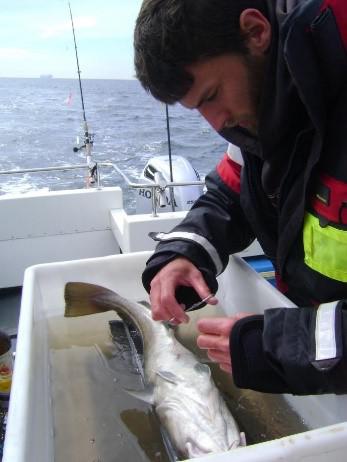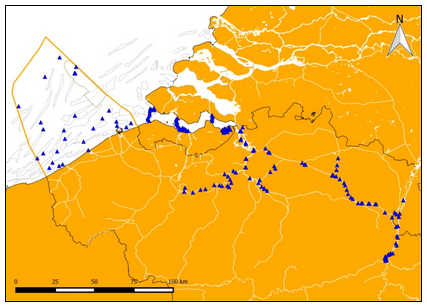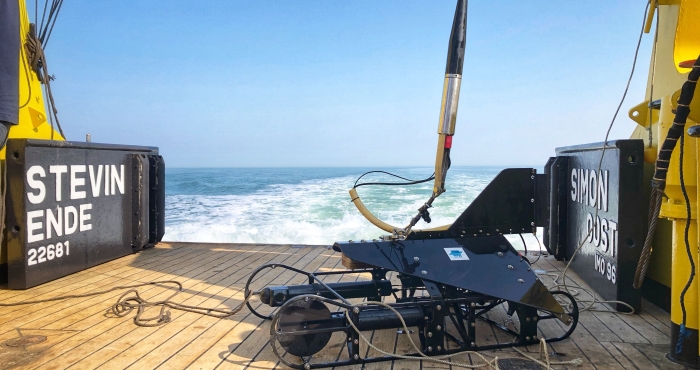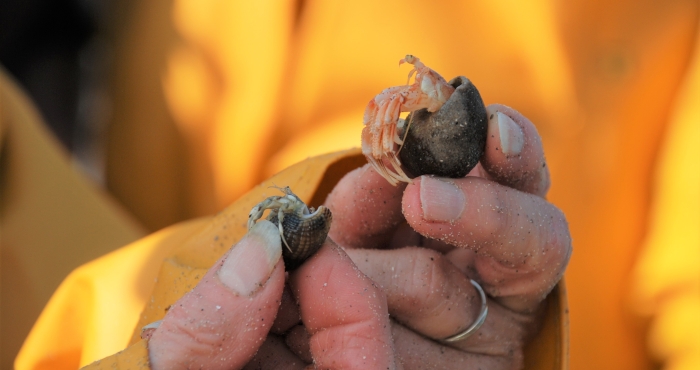Publications
Verhelst, P.; De Meyer, J.; Reubens, J.; Coeck, J.; Goethals, P.; Moens, T.; Mouton, A.M. (2018). Unimodal head-width distribution of the European eel (Anguilla anguilla L.) from the Zeeschelde does not support disruptive selection. PeerJ 6: e5773.
Verhelst, P.; Bruneel, S.; Reubens, J.; Coeck, J.; Goethals, P.; Oldoni, D.; Moens, T.; Mouton, A. (2018). Selective tidal stream transport in silver European eel (Anguilla anguilla L.) – Migration behaviour in a dynamic estuary. Est., Coast. and Shelf Sci. 213: 260-268.
Verhelst P.; Baeyens R.; Reubens J.; Benitez J.; Coeck J.; Goethals P.; Ovidio M.; Vergeynst J.; Moens T.; Mouton A.. (2018). European silver eel (Anguilla anguilla L.) migration behaviour in a highly regulated shipping canal. Fish. Res. 206: 176 - 184.
Verhelst, P.; Reubens, J.; Pauwels, I.; Buysse, D.; Aelterman, B.; Van Hoey, S.; Goethals, P.; Moens, T.; Coeck, J.; Mouton, A. (2018). Movement behaviour of large female yellow European eel (Anguilla anguilla L.) in a freshwater polder area. Ecol. Freshw. Fish. 27(1): 471-480.
Verhelst, P.; Buysse, D.; Reubens, J.; Pauwels, I.; Aelterman, B.; Van Hoey, S.; Goethals, P.; Moens, T. (2018). Downstream migration of European eel (Anguilla anguilla L.) in an anthropogenically regulated freshwater system: Implications for management. Fish. Res. 199: 252-262.
Verhelst, P.; Boets, P.; Van Thuyne, G.; Verreycken, H.; Goethals, P.L.M.; Mouton, A. (2016). The distribution of an invasive fish species is highly affected by the presence of native fish species: evidence based on species distribution modelling. Biological Invasions 18(2): 427-444.
Reubens, J.; Verhelst, P.; van der Knaap, I; Deneudt, K.; Moens, T.; Hernandez, F. (2018). Environmental factors influence the detection probability in acoustic telemetry in a marine environment: results from a new setup. Hydrobiologia Online: 1–14.
Bruneel, S.; Gobeyn, S.; Verhelst, P.; Reubens, J.; Moens, T.; Goethals, P. (2018). Implications of movement for species distribution models - rethinking environmental data tools. Sci. Total Environ. 628-629: 893-905.
Breine, J.; Pauwels, I.; Verhelst, P.; Vandamme, L.; Baeyens, R.; Reubens, J.; Coeck, J. (2017). Successful external acoustic tagging of twaite shad Alosa fallax (Lacépède 1803). Fish. Res. 191: 36-40.
Huisman, J.; Verhelst, P.; Deneudt, K.; Goethals, P.L.M.; Moens, T.; Nagelkerke, L.A.J.; Nolting, C.; Reubens, J.; Schollema, P.P.; Winter, H.V.; Mouton, A. (2016). Heading south or north: novel insights on European silver eel Anguilla anguilla migration in the North Sea. Mar. Ecol. Prog. Ser. 554: 257-262.
Scripts
Some of Pieterjan’s R scripts are available on his Github page.
Awards
As the laureate of the 2016 VLIZ Communication Award, Pieterjan could benefit from a personal communication coaching by the VLIZ Communication division. This collaboration resulted in an educational video on eel migrations and acoustic telemetry.
News and outreach
2020-03-17, Cefas Technology Limited Blog: The Mystery of European Eel migration
2020-03-10, BBC news, Tracking European eels in the English Channel
2020 March to May, Exhibition at the Blankaart: Paling in 't rood
2020-04-02, Seminar at the Blankaart: Avondje Over... Van de paling geen nieuws!?
2020-01-26, Zeeuitzicht: De mysterieuze zeereis van de paling
2019-12-28, De Standaard: Onze paling is een zorgenkind
2019-12-19, Eos Wetenschap: Zenderonderzoek moet paling van ondergang redden
2019-09-19, Eos Wetenschap: Paling in 't rood
2018-11-11, Gazet van Antwerpen: Paaiproces van de paling is nog altijd door niemand waargenomen: hoe doen ze het toch?
2018-11-09, De Standaard: Strandjutters kunnen 50 euro verdienen met palingzender
2018-11-09, Radio2: De parende paling
2018-05-26, Radio1: Hoe zit het met de Belgische vis en hoe wordt dat eigenlijk gemeten?
2017-03-20, Visionair: Shortcuts voor Paling
2016-12-15, LifeWatch.be news: Aristoteles en soortenverspreiding en migratiepatronen
2016-10-31, Vroege Vogel TV: Moeflons op de Veluwe en palingen zenderen
Contact
E-mail: Pieterjan.Verhelst@UGent.be
Tel.: +32 499 38 72 87Find Pieterjan on ResearchGate.
Institutes
Pieterjan Verhelst holds a doctoral grant from the Flemish Agency for Innovation & Entrepreneurship (VLAIO), now under the auspices of the National Science Fund FWO and is affiliated with Ghent University. Pieterjan works in close collaboration with the Research Institute for Nature and Forest (INBO) and the Flanders Marine Institute (VLIZ).
Useful links
Fish acoustic receiver network: Learn about the fish telemetry network of the Belgian LifeWatch Observatory.
ETN: Access, store and share fish tracking data on the European Tracking Network data platform.
Data explorer: Access and explore the acoustic fish detection data with the LifeWatch data explorer.
LifeWatch GitHub: Find the scripts and tutorials developed for the use of data of the LifeWatch Infrastructure.
Marine VRE: Use the developed web services of the LifeWatch Marine Virtual Research Environment.






